Abstract
In recent years there has been considerable interest in the effect of variations in activities of xenobiotic-metabolizing enzymes on cancer incidence. This interest has accelerated with the development of methods for analyzing genetic polymorphisms. However, progress in epidemiology has been slow and the contributions of polymorphisms to risks from individual chemicals and mixtures are often controversial. A series of studies is presented to show the complexities encountered with a single chemical, aflatoxin B1 (AFB1). AFB1 is oxidized by human cytochrome P450 enzymes to several products. Only one of these, the 8,9-exo-epoxide, appears to be mutagenic and the others are detoxication products. P450 3A4, which can both activate and detoxicate AFB1, is found in the liver and the small intestine. In the small intestine, the first contact after oral exposure, epoxidation would not lead to liver cancer. The (nonenzymatic) half-life of the epoxide has been determined to be approximately 1 sec at 23 degrees C and neutral pH. Although the half-life is short, AFB1-8,9-exo-epoxide does react with DNA and glutathione S-transferase. Levels of these conjugates have been measured and combined with the rate of hydrolysis in a kinetic model to predict constants for binding of the epoxide with DNA and glutathione S-transferase. A role for epoxide hydrolase in alteration of AFB1 hepatocarcinogenesis has been proposed, although experimental evidence is lacking. Some inhibition of microsome-generated genotoxicity was observed with rat epoxide hydrolase; further information on the extent of contribution of this enzyme to AFB1 metabolism is not yet available.
Full text
PDF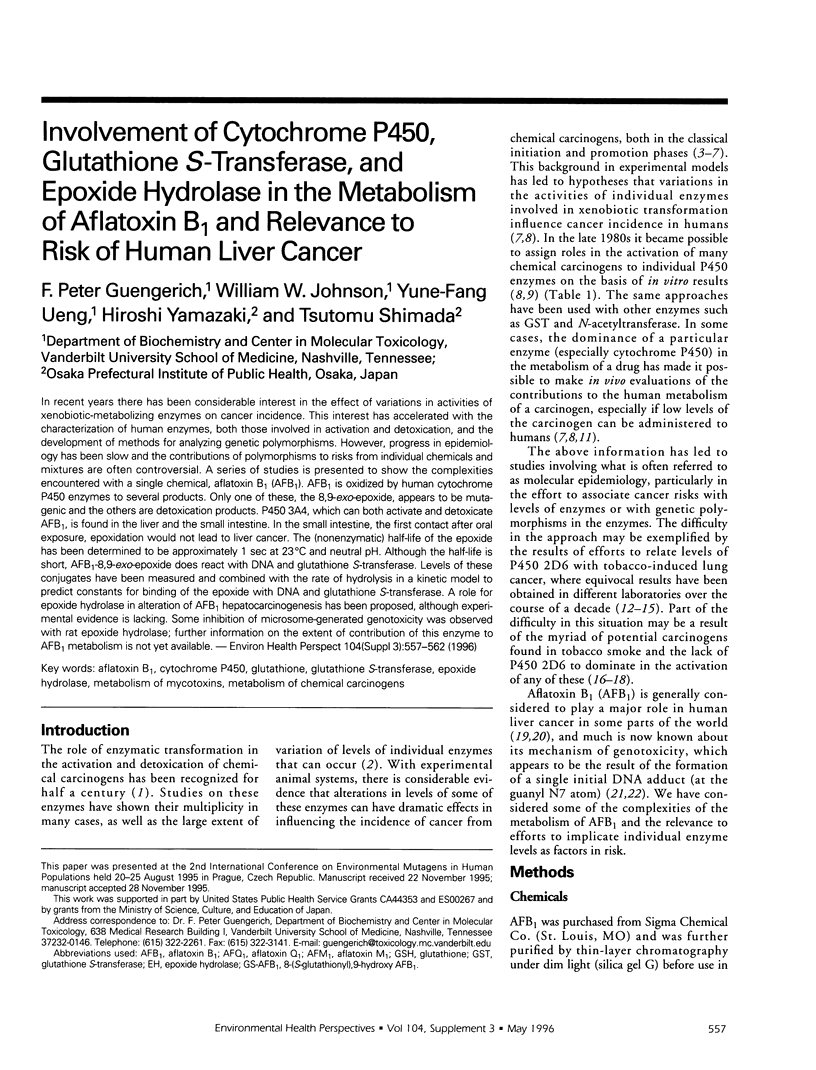
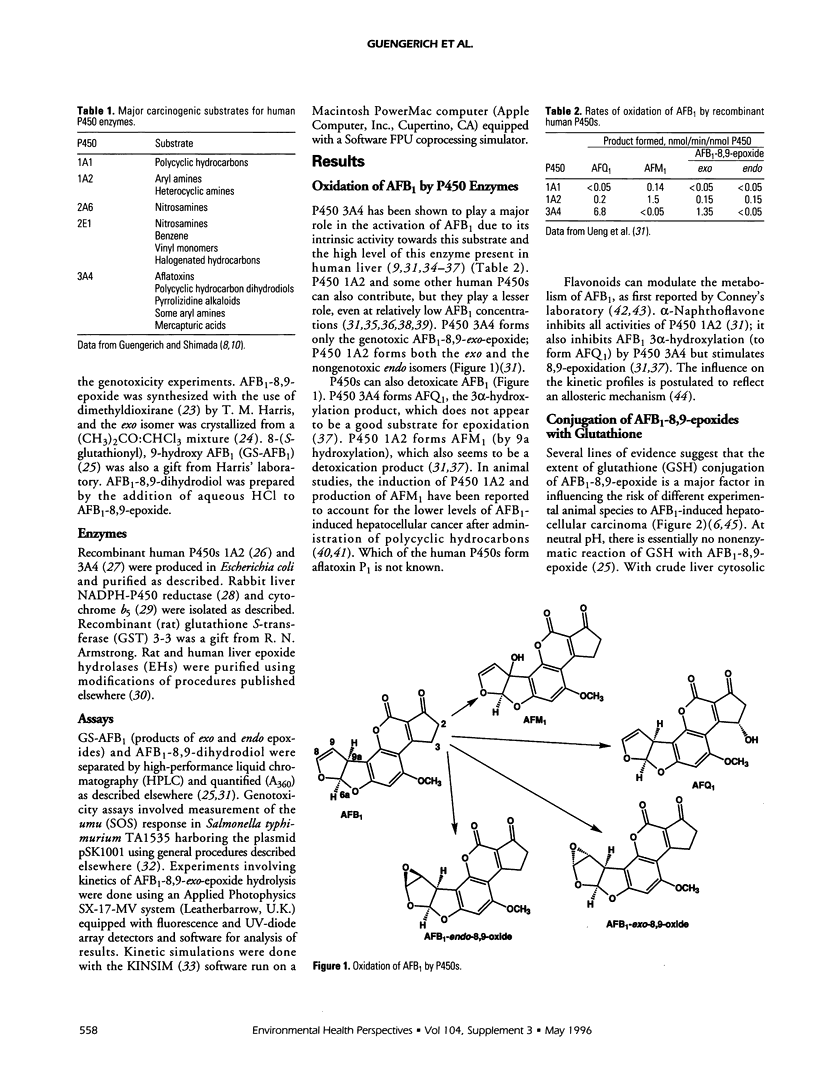
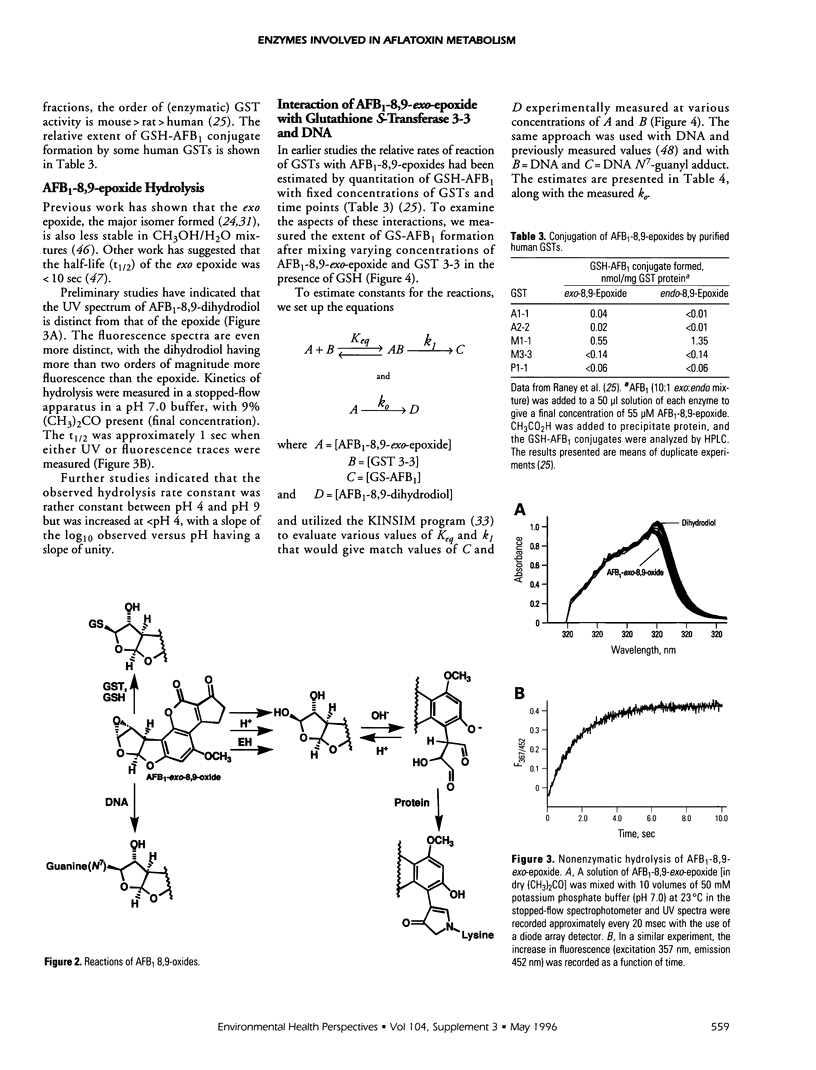
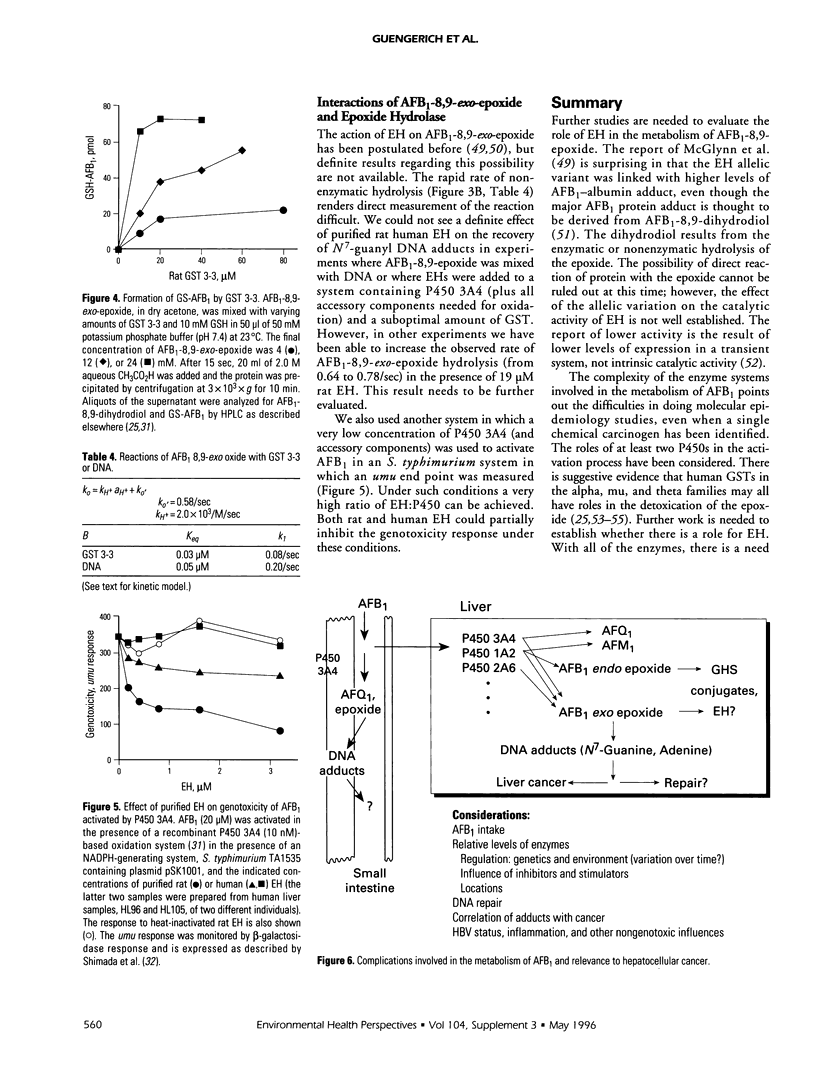
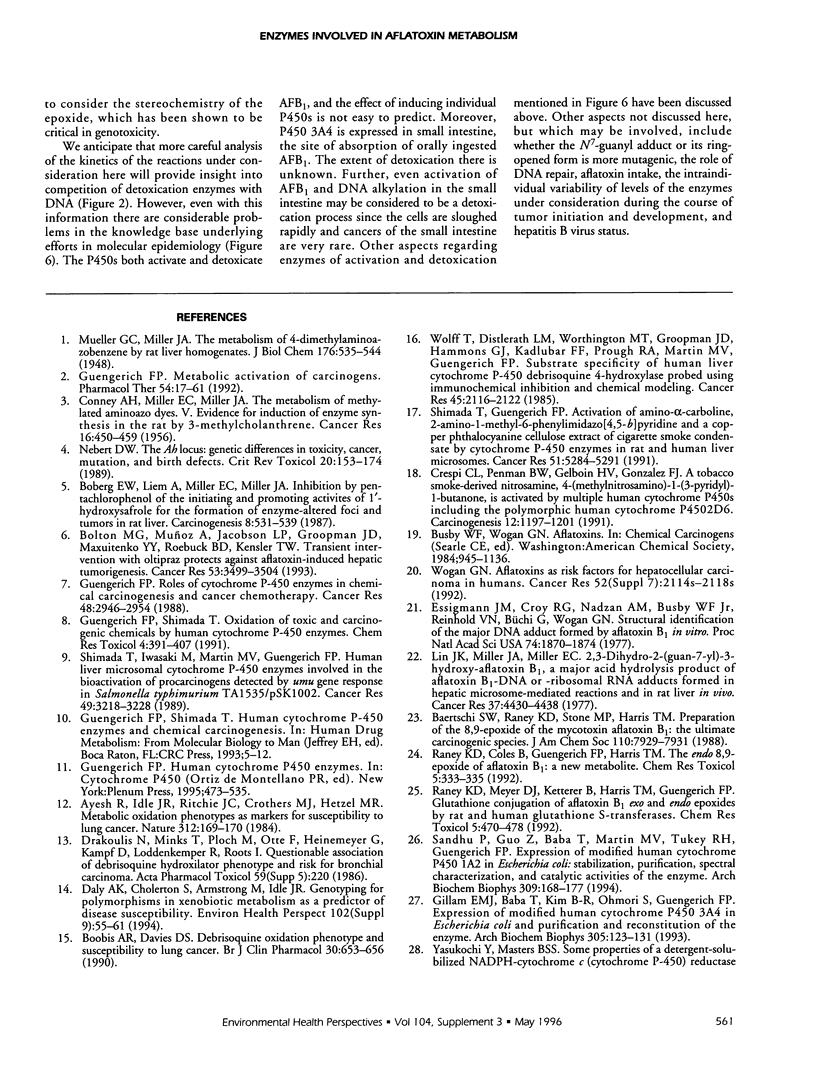
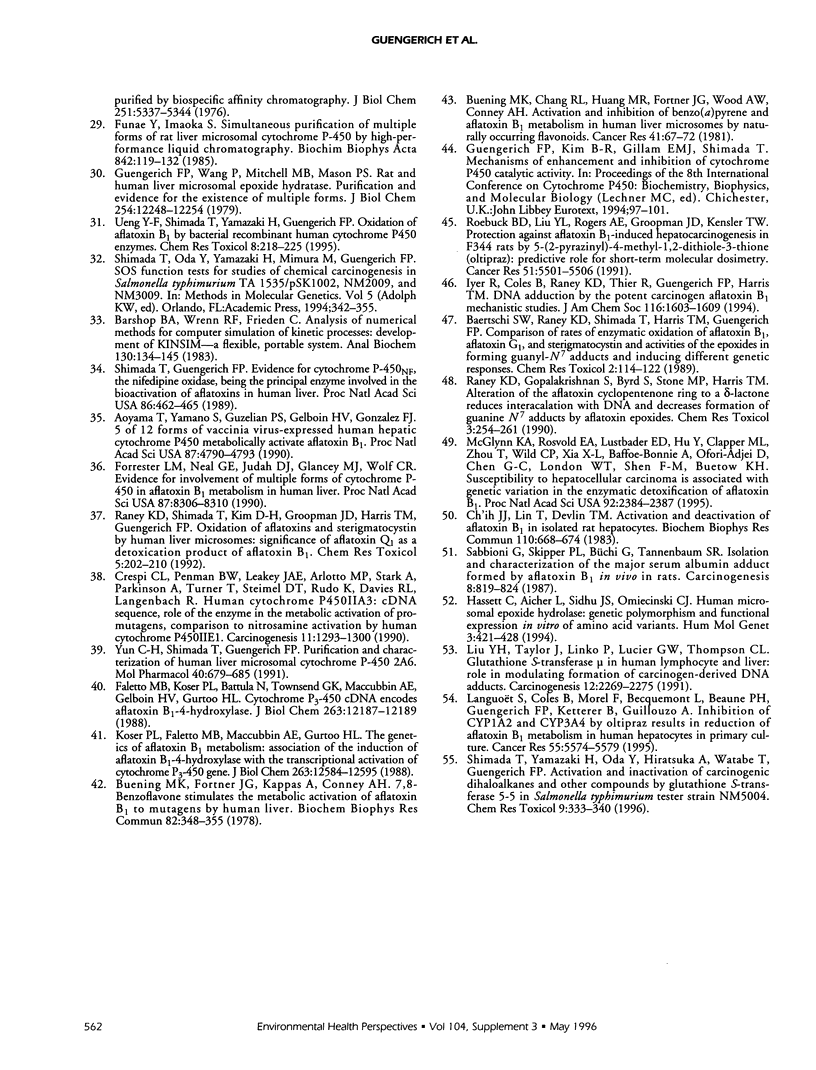
Selected References
These references are in PubMed. This may not be the complete list of references from this article.
- Aoyama T., Yamano S., Guzelian P. S., Gelboin H. V., Gonzalez F. J. Five of 12 forms of vaccinia virus-expressed human hepatic cytochrome P450 metabolically activate aflatoxin B1. Proc Natl Acad Sci U S A. 1990 Jun;87(12):4790–4793. doi: 10.1073/pnas.87.12.4790. [DOI] [PMC free article] [PubMed] [Google Scholar]
- Ayesh R., Idle J. R., Ritchie J. C., Crothers M. J., Hetzel M. R. Metabolic oxidation phenotypes as markers for susceptibility to lung cancer. Nature. 1984 Nov 8;312(5990):169–170. doi: 10.1038/312169a0. [DOI] [PubMed] [Google Scholar]
- Baertschi S. W., Raney K. D., Shimada T., Harris T. M., Guengerich F. P. Comparison of rates of enzymatic oxidation of aflatoxin B1, aflatoxin G1, and sterigmatocystin and activities of the epoxides in forming guanyl-N7 adducts and inducing different genetic responses. Chem Res Toxicol. 1989 Mar-Apr;2(2):114–112. doi: 10.1021/tx00008a008. [DOI] [PubMed] [Google Scholar]
- Barshop B. A., Wrenn R. F., Frieden C. Analysis of numerical methods for computer simulation of kinetic processes: development of KINSIM--a flexible, portable system. Anal Biochem. 1983 Apr 1;130(1):134–145. doi: 10.1016/0003-2697(83)90660-7. [DOI] [PubMed] [Google Scholar]
- Boberg E. W., Liem A., Miller E. C., Miller J. A. Inhibition by pentachlorophenol of the initiating and promoting activities of 1'-hydroxysafrole for the formation of enzyme-altered foci and tumors in rat liver. Carcinogenesis. 1987 Apr;8(4):531–539. doi: 10.1093/carcin/8.4.531. [DOI] [PubMed] [Google Scholar]
- Bolton M. G., Muñoz A., Jacobson L. P., Groopman J. D., Maxuitenko Y. Y., Roebuck B. D., Kensler T. W. Transient intervention with oltipraz protects against aflatoxin-induced hepatic tumorigenesis. Cancer Res. 1993 Aug 1;53(15):3499–3504. [PubMed] [Google Scholar]
- Boobis A. R., Davies D. S. Debrisoquine oxidation phenotype and susceptibility to lung cancer. Br J Clin Pharmacol. 1990 Oct;30(4):653–656. doi: 10.1111/j.1365-2125.1990.tb03832.x. [DOI] [PMC free article] [PubMed] [Google Scholar]
- Buening M. K., Chang R. L., Huang M. T., Fortner J. G., Wood A. W., Conney A. H. Activation and inhibition of benzo(a)pyrene and aflatoxin B1 metabolism in human liver microsomes by naturally occurring flavonoids. Cancer Res. 1981 Jan;41(1):67–72. [PubMed] [Google Scholar]
- Buening M. K., Fortner J. G., Kappas A., Corney A. H. 7,8-Benzoflavone stimulates the metabolic activation of aflatoxin B1 to mutagens by human liver. Biochem Biophys Res Commun. 1978 May 15;82(1):348–355. doi: 10.1016/0006-291x(78)90616-2. [DOI] [PubMed] [Google Scholar]
- CONNEY A. H., MILLER E. C., MILLER J. A. The metabolism of methylated aminoazo dyes. V. Evidence for induction of enzyme synthesis in the rat by 3-methylcholanthrene. Cancer Res. 1956 Jun;16(5):450–459. [PubMed] [Google Scholar]
- Ch'ih J. J., Lin T., Devlin T. M. Activation and deactivation of aflatoxin B1 in isolated rat hepatocytes. Biochem Biophys Res Commun. 1983 Jan 27;110(2):668–674. doi: 10.1016/0006-291x(83)91201-9. [DOI] [PubMed] [Google Scholar]
- Crespi C. L., Penman B. W., Gelboin H. V., Gonzalez F. J. A tobacco smoke-derived nitrosamine, 4-(methylnitrosamino)-1-(3-pyridyl)-1-butanone, is activated by multiple human cytochrome P450s including the polymorphic human cytochrome P4502D6. Carcinogenesis. 1991 Jul;12(7):1197–1201. doi: 10.1093/carcin/12.7.1197. [DOI] [PubMed] [Google Scholar]
- Crespi C. L., Penman B. W., Leakey J. A., Arlotto M. P., Stark A., Parkinson A., Turner T., Steimel D. T., Rudo K., Davies R. L. Human cytochrome P450IIA3: cDNA sequence, role of the enzyme in the metabolic activation of promutagens, comparison to nitrosamine activation by human cytochrome P450IIE1. Carcinogenesis. 1990 Aug;11(8):1293–1300. doi: 10.1093/carcin/11.8.1293. [DOI] [PubMed] [Google Scholar]
- Daly A. K., Cholerton S., Armstrong M., Idle J. R. Genotyping for polymorphisms in xenobiotic metabolism as a predictor of disease susceptibility. Environ Health Perspect. 1994 Nov;102 (Suppl 9):55–61. doi: 10.1289/ehp.94102s955. [DOI] [PMC free article] [PubMed] [Google Scholar]
- Essigmann J. M., Croy R. G., Nadzan A. M., Busby W. F., Jr, Reinhold V. N., Büchi G., Wogan G. N. Structural identification of the major DNA adduct formed by aflatoxin B1 in vitro. Proc Natl Acad Sci U S A. 1977 May;74(5):1870–1874. doi: 10.1073/pnas.74.5.1870. [DOI] [PMC free article] [PubMed] [Google Scholar]
- Faletto M. B., Koser P. L., Battula N., Townsend G. K., Maccubbin A. E., Gelboin H. V., Gurtoo H. L. Cytochrome P3-450 cDNA encodes aflatoxin B1-4-hydroxylase. J Biol Chem. 1988 Sep 5;263(25):12187–12189. [PubMed] [Google Scholar]
- Forrester L. M., Neal G. E., Judah D. J., Glancey M. J., Wolf C. R. Evidence for involvement of multiple forms of cytochrome P-450 in aflatoxin B1 metabolism in human liver. Proc Natl Acad Sci U S A. 1990 Nov;87(21):8306–8310. doi: 10.1073/pnas.87.21.8306. [DOI] [PMC free article] [PubMed] [Google Scholar]
- Funae Y., Imaoka S. Simultaneous purification of multiple forms of rat liver microsomal cytochrome P-450 by high-performance liquid chromatography. Biochim Biophys Acta. 1985 Oct 17;842(2-3):119–132. doi: 10.1016/0304-4165(85)90193-x. [DOI] [PubMed] [Google Scholar]
- Gillam E. M., Baba T., Kim B. R., Ohmori S., Guengerich F. P. Expression of modified human cytochrome P450 3A4 in Escherichia coli and purification and reconstitution of the enzyme. Arch Biochem Biophys. 1993 Aug 15;305(1):123–131. doi: 10.1006/abbi.1993.1401. [DOI] [PubMed] [Google Scholar]
- Guengerich F. P. Metabolic activation of carcinogens. Pharmacol Ther. 1992;54(1):17–61. doi: 10.1016/0163-7258(92)90050-a. [DOI] [PubMed] [Google Scholar]
- Guengerich F. P. Roles of cytochrome P-450 enzymes in chemical carcinogenesis and cancer chemotherapy. Cancer Res. 1988 Jun 1;48(11):2946–2954. [PubMed] [Google Scholar]
- Guengerich F. P., Shimada T. Oxidation of toxic and carcinogenic chemicals by human cytochrome P-450 enzymes. Chem Res Toxicol. 1991 Jul-Aug;4(4):391–407. doi: 10.1021/tx00022a001. [DOI] [PubMed] [Google Scholar]
- Guengerich F. P., Wang P., Mitchell M. B., Mason P. S. Rat and human liver microsomal epoxide hydratase. Purification and evidence for the existence of multiple forms. J Biol Chem. 1979 Dec 10;254(23):12248–12254. [PubMed] [Google Scholar]
- Hassett C., Aicher L., Sidhu J. S., Omiecinski C. J. Human microsomal epoxide hydrolase: genetic polymorphism and functional expression in vitro of amino acid variants. Hum Mol Genet. 1994 Mar;3(3):421–428. doi: 10.1093/hmg/3.3.421. [DOI] [PMC free article] [PubMed] [Google Scholar]
- Koser P. L., Faletto M. B., Maccubbin A. E., Gurtoo H. L. The genetics of aflatoxin B1 metabolism. Association of the induction of aflatoxin B1-4-hydroxylase with the transcriptional activation of cytochrome P3-450 gene. J Biol Chem. 1988 Sep 5;263(25):12584–12595. [PubMed] [Google Scholar]
- Langouët S., Coles B., Morel F., Becquemont L., Beaune P., Guengerich F. P., Ketterer B., Guillouzo A. Inhibition of CYP1A2 and CYP3A4 by oltipraz results in reduction of aflatoxin B1 metabolism in human hepatocytes in primary culture. Cancer Res. 1995 Dec 1;55(23):5574–5579. [PubMed] [Google Scholar]
- Lin J. K., Miller J. A., Miller E. C. 2,3-Dihydro-2-(guan-7-yl)-3-hydroxy-aflatoxin B1, a major acid hydrolysis product of aflatoxin B1-DNA or -ribosomal RNA adducts formed in hepatic microsome-mediated reactions and in rat liver in vivo. Cancer Res. 1977 Dec;37(12):4430–4438. [PubMed] [Google Scholar]
- Liu Y. H., Taylor J., Linko P., Lucier G. W., Thompson C. L. Glutathione S-transferase mu in human lymphocyte and liver: role in modulating formation of carcinogen-derived DNA adducts. Carcinogenesis. 1991 Dec;12(12):2269–2275. doi: 10.1093/carcin/12.12.2269. [DOI] [PubMed] [Google Scholar]
- McGlynn K. A., Rosvold E. A., Lustbader E. D., Hu Y., Clapper M. L., Zhou T., Wild C. P., Xia X. L., Baffoe-Bonnie A., Ofori-Adjei D. Susceptibility to hepatocellular carcinoma is associated with genetic variation in the enzymatic detoxification of aflatoxin B1. Proc Natl Acad Sci U S A. 1995 Mar 14;92(6):2384–2387. doi: 10.1073/pnas.92.6.2384. [DOI] [PMC free article] [PubMed] [Google Scholar]
- Nebert D. W. The Ah locus: genetic differences in toxicity, cancer, mutation, and birth defects. Crit Rev Toxicol. 1989;20(3):153–174. doi: 10.3109/10408448909017908. [DOI] [PubMed] [Google Scholar]
- Raney K. D., Coles B., Guengerich F. P., Harris T. M. The endo-8,9-epoxide of aflatoxin B1: a new metabolite. Chem Res Toxicol. 1992 May-Jun;5(3):333–335. doi: 10.1021/tx00027a002. [DOI] [PubMed] [Google Scholar]
- Raney K. D., Gopalakrishnan S., Byrd S., Stone M. P., Harris T. M. Alteration of the aflatoxin cyclopentenone ring to a delta-lactone reduces intercalation with DNA and decreases formation of guanine N7 adducts by aflatoxin epoxides. Chem Res Toxicol. 1990 May-Jun;3(3):254–261. doi: 10.1021/tx00015a011. [DOI] [PubMed] [Google Scholar]
- Raney K. D., Meyer D. J., Ketterer B., Harris T. M., Guengerich F. P. Glutathione conjugation of aflatoxin B1 exo- and endo-epoxides by rat and human glutathione S-transferases. Chem Res Toxicol. 1992 Jul-Aug;5(4):470–478. doi: 10.1021/tx00028a004. [DOI] [PubMed] [Google Scholar]
- Raney K. D., Shimada T., Kim D. H., Groopman J. D., Harris T. M., Guengerich F. P. Oxidation of aflatoxins and sterigmatocystin by human liver microsomes: significance of aflatoxin Q1 as a detoxication product of aflatoxin B1. Chem Res Toxicol. 1992 Mar-Apr;5(2):202–210. doi: 10.1021/tx00026a009. [DOI] [PubMed] [Google Scholar]
- Roebuck B. D., Liu Y. L., Rogers A. E., Groopman J. D., Kensler T. W. Protection against aflatoxin B1-induced hepatocarcinogenesis in F344 rats by 5-(2-pyrazinyl)-4-methyl-1,2-dithiole-3-thione (oltipraz): predictive role for short-term molecular dosimetry. Cancer Res. 1991 Oct 15;51(20):5501–5506. [PubMed] [Google Scholar]
- Sabbioni G., Skipper P. L., Büchi G., Tannenbaum S. R. Isolation and characterization of the major serum albumin adduct formed by aflatoxin B1 in vivo in rats. Carcinogenesis. 1987 Jun;8(6):819–824. doi: 10.1093/carcin/8.6.819. [DOI] [PubMed] [Google Scholar]
- Sandhu P., Guo Z., Baba T., Martin M. V., Tukey R. H., Guengerich F. P. Expression of modified human cytochrome P450 1A2 in Escherichia coli: stabilization, purification, spectral characterization, and catalytic activities of the enzyme. Arch Biochem Biophys. 1994 Feb 15;309(1):168–177. doi: 10.1006/abbi.1994.1099. [DOI] [PubMed] [Google Scholar]
- Shimada T., Guengerich F. P. Activation of amino-alpha-carboline, 2-amino-1-methyl-6-phenylimidazo[4,5-b]pyridine and a copper phthalocyanine cellulose extract of cigarette smoke condensate by cytochrome P-450 enzymes in rat and human liver microsomes. Cancer Res. 1991 Oct 1;51(19):5284–5291. [PubMed] [Google Scholar]
- Shimada T., Guengerich F. P. Evidence for cytochrome P-450NF, the nifedipine oxidase, being the principal enzyme involved in the bioactivation of aflatoxins in human liver. Proc Natl Acad Sci U S A. 1989 Jan;86(2):462–465. doi: 10.1073/pnas.86.2.462. [DOI] [PMC free article] [PubMed] [Google Scholar]
- Shimada T., Iwasaki M., Martin M. V., Guengerich F. P. Human liver microsomal cytochrome P-450 enzymes involved in the bioactivation of procarcinogens detected by umu gene response in Salmonella typhimurium TA 1535/pSK1002. Cancer Res. 1989 Jun 15;49(12):3218–3228. [PubMed] [Google Scholar]
- Shimada T., Yamazaki H., Oda Y., Hiratsuka A., Watabe T., Guengerich F. P. Activation and inactivation of carcinogenic dihaloalkanes and other compounds by glutathione S-transferase 5-5 in Salmonella typhimurium tester strain NM5004. Chem Res Toxicol. 1996 Jan-Feb;9(1):333–340. doi: 10.1021/tx950125v. [DOI] [PubMed] [Google Scholar]
- Ueng Y. F., Shimada T., Yamazaki H., Guengerich F. P. Oxidation of aflatoxin B1 by bacterial recombinant human cytochrome P450 enzymes. Chem Res Toxicol. 1995 Mar;8(2):218–225. doi: 10.1021/tx00044a006. [DOI] [PubMed] [Google Scholar]
- Wogan G. N. Aflatoxins as risk factors for hepatocellular carcinoma in humans. Cancer Res. 1992 Apr 1;52(7 Suppl):2114s–2118s. [PubMed] [Google Scholar]
- Wolff T., Distlerath L. M., Worthington M. T., Groopman J. D., Hammons G. J., Kadlubar F. F., Prough R. A., Martin M. V., Guengerich F. P. Substrate specificity of human liver cytochrome P-450 debrisoquine 4-hydroxylase probed using immunochemical inhibition and chemical modeling. Cancer Res. 1985 May;45(5):2116–2122. [PubMed] [Google Scholar]
- Yasukochi Y., Masters B. S. Some properties of a detergent-solubilized NADPH-cytochrome c(cytochrome P-450) reductase purified by biospecific affinity chromatography. J Biol Chem. 1976 Sep 10;251(17):5337–5344. [PubMed] [Google Scholar]
- Yun C. H., Shimada T., Guengerich F. P. Purification and characterization of human liver microsomal cytochrome P-450 2A6. Mol Pharmacol. 1991 Nov;40(5):679–685. [PubMed] [Google Scholar]


